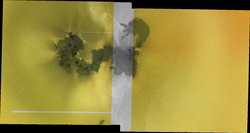
Prometheus is an active volcano on Jupiter's moon Io. It is located on Io's hemisphere facing away from Jupiter at 1°31′S153°56′W / 1.52°S 153.94°W . [2]

Prometheus is an active volcano on Jupiter's moon Io. It is located on Io's hemisphere facing away from Jupiter at 1°31′S153°56′W / 1.52°S 153.94°W . [2]
Prometheus consists of a 28-kilometer-wide (17 mi) volcanic pit named Prometheus Patera and a 100-kilometer-long (62 mi) compound lava flow, all surrounded by reddish sulfur and circular, bright sulfur dioxide (SO
2) volcanic plume deposits. [3] The volcano was first observed in images acquired by the Voyager 1 spacecraft in March 1979. [4] Later that year, the International Astronomical Union named this feature after a Greek fire god, Prometheus.
Prometheus is the site of a volcanic eruption that has been ongoing since at least the Voyager 1 encounter in 1979. Between the Voyager encounters and the first observations by Galileo , a 6,700-square-kilometer (2,600 sq mi) flow field was emplaced. [5] Later Galileo observations of this flow field revealed numerous small breakouts, particularly on the western end of the flow field. [6]
Prometheus is the site of two volcanic eruption plumes: a small, sulfur-rich plume erupting from the magma-source vent at the eastern end of the flow field and a 75-to-100-kilometer-tall (47 to 62 mi), SO
2-rich dust plume erupting from the active flow front at the other end. [3] The former forms a diffuse, red deposit to the east of the Prometheus flow field. The latter forms a bright, circular deposit surrounding the entire volcano and lava flow. The SO
2-rich plume is generated as lava at the western end of the flow field covers sulfur dioxide frost, heating and vaporizing it. [7] This is accomplished at multiple breakouts, generating gas and dust for the visible dust plume. [8] Prometheus' plume has been observed by both Voyager spacecraft, Galileo, and New Horizons , at every appropriate imaging opportunity.
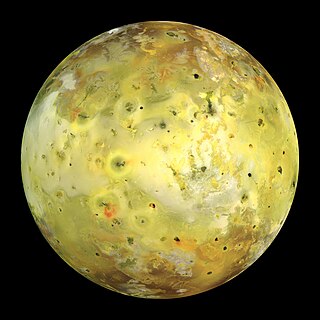
Io, or Jupiter I, is the innermost and second-smallest of the four Galilean moons of the planet Jupiter. Slightly larger than Earth's moon, Io is the fourth-largest moon in the Solar System, has the highest density of any moon, the strongest surface gravity of any moon, and the lowest amount of water by atomic ratio of any known astronomical object in the Solar System. It was discovered in 1610 by Galileo Galilei and was named after the mythological character Io, a priestess of Hera who became one of Zeus's lovers.
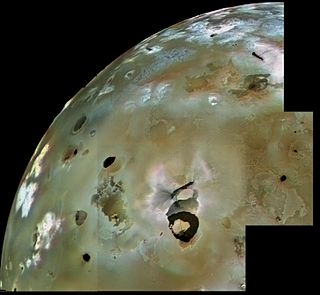
Loki Patera is the largest volcanic depression on Jupiter's moon Io, 202 kilometres (126 mi) in diameter. It contains an active lava lake, with an episodically overturning crust. The level of activity seen is similar to a superfast spreading mid-ocean ridge on Earth. Temperature measurements of thermal emission at Loki Patera taken by Voyager 1's Infrared Interferometer Spectrometer and Radiometer (IRIS) instrument were consistent with sulfur volcanism.
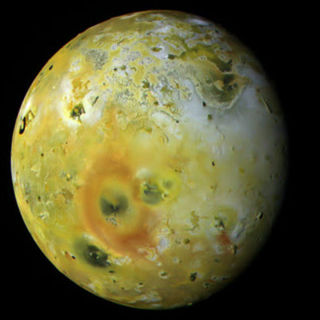
Pele is an active volcano on the surface of Jupiter's moon Io. It is located on Io's trailing hemisphere at 18.7°S 255.3°W. A large, 300-kilometer (190 mi) tall volcanic plume has been observed at Pele by various spacecraft starting with Voyager 1 in 1979, though it has not been persistent. The discovery of the Pele plume on March 8, 1979 confirmed the existence of active volcanism on Io. The plume is associated with a lava lake at the northern end of the mountain Danube Planum. Pele is also notable for a persistent, large red ring circling the volcano resulting from sulfurous fallout from the volcanic plume.

Volcanism on Io, a moon of Jupiter, is represented by the presence of volcanoes, volcanic pits and lava flows on the moon's surface. Its volcanic activity was discovered in 1979 by Voyager 1 imaging scientist Linda Morabito. Observations of Io by passing spacecraft and Earth-based astronomers have revealed more than 150 active volcanoes. Up to 400 such volcanoes are predicted to exist based on these observations. Io's volcanism makes the satellite one of only five known currently volcanically or cryovolcanically active worlds in the Solar System

Monan Patera is a patera, or a complex crater with scalloped edges, on Jupiter's moon Io. It is about 137 kilometers in diameter and is located at 19.82°N 104.81°W. It is named after Monan, a god in Brazilian mythology that destroyed the world with fire and floods. Its name was adopted by the International Astronomical Union in 1997.

Pillan Patera is a patera, or a complex crater with scalloped edges, on Jupiter's moon Io. It is located at 12.34°S 243.25°W, south of Pillan Mons and west of Reiden Patera. It is named after the Araucanian thunder, fire, and volcano god. Its name was approved by the International Astronomical Union in 1997.

Surt is an active volcano on Jupiter's moon Io. It is located on Io's Jupiter-facing hemisphere at 45.21°N 336.49°W. Surt consists of an oblong volcanic pit, 75 by 40 kilometres in diameter, surrounded by reddish sulfur and bright sulfur dioxide deposits to its south and east. The volcano was first observed in images acquired by the Voyager 1 spacecraft in March 1979. Later that year, the International Astronomical Union named this feature after Surtr, a leader of the fire giants of Norse mythology.

Amirani is an active volcano on Jupiter's moon Io, the inner-most of the Galilean Moons. It is located on Io's leading hemisphere at 24.46°N 114.68°W. The volcano is responsible for the largest active lava flow in the entire Solar System, with recent flows dwarfing those of even other volcanos on Io.

Masubi is an active volcano on Jupiter's moon Io. It is located on Io's leading hemisphere at 49.6°S 56.18°W within a bright terrain region named Tarsus Regio. A volcanic plume has been observed at Masubi by various spacecraft starting with Voyager 1 in 1979, though it has not been persistent like similar Ionian volcanoes Amirani and Prometheus. Masubi is also notable for having one of the largest active lava flows on Io, with an additional 240 km (150 mi) flow forming between 1999 and 2007.

Tupan Patera is an active volcano on Jupiter's moon Io. It is located on Io's anti-Jupiter hemisphere at 18.73°S 141.13°W. Tupan consists of a volcanic crater, known as a patera, 79 kilometers across and 900 meters deep. The volcano was first seen in low-resolution observations by the two Voyager spacecraft in 1979, but volcanic activity was not seen at this volcano until June 1996 during the Galileo spacecraft's first orbit. Following this first detection of near-infrared thermal emission and subsequent detections by Galileo during the next few orbits, this volcano was formally named Tupan Patera, after the thunder god of the Tupí-Guaraní indigenous peoples in Brazil, by the International Astronomical Union in 1997.

Tawhaki Vallis is a shallow valley on Jupiter's moon Io. It is located on Io's leading hemisphere in the equatorial plains of western Media Regio at 0.5°N 72.8°W. The valley is 190 kilometers long, 0.5 to 6 km wide, and 40 to 65 meters deep. Due to the shallow depth and lack of brightness or color variations associated with it, Tawhaki Vallis was seen in only a single, high-spatial-resolution observation taken by Galileo during an Io encounter on November 26, 1999. The northern and southern ends of the valley are cut off by the northern margin of the observation and the dusk terminator, so Tawhaki could be longer than the measured length. The valley was formally named Tawhaki Vallis by the International Astronomical Union in 2006 after a nearby volcano, Tawhaki Patera, and the Māori lightning god, Tāwhaki.

Tawhaki Patera is an active volcano on Jupiter's moon Io. It is located on Io's leading hemisphere at 3.32°N 76.18°W within the equatorial plains of western Media Regio. Tawhaki is an Ionian patera, a type of volcanic crater similar to a caldera, 49.8 kilometers (30.9 mi) wide and 550 meters (1,800 ft) deep.
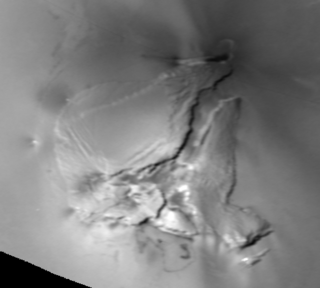
Danube Planum is a rifted mesa on the surface of Jupiter's moon Io. It is located on Io's trailing hemisphere at 22.73°S 257.44°W. Danube Planum is 244.22 kilometers across and 5.5 km tall. The mountain is bisected by a 15-to-25-kilometer-wide, northeast–southwest-trending canyon, splitting the mountain into two main east and west mountains, with several additional blocks at the southern end of the fracture. The outer margin of the plateau is marked by 2.6-to-3.4-km-tall scarps. Mass wasting in the form of landslide deposits are visible along the base of the western half of Danube Planum. Two volcanic depressions, known as paterae, lie at northern and southern ends of mountain. The volcano at the northern end, Pele, is one of the most active volcanoes on Io. One of the faults that helped form Danube Planum may also act as a conduit for magma to rise to the surface at Pele.

The exploration of Io, Jupiter's innermost Galilean and third-largest moon, began with its discovery in 1610 and continues today with Earth-based observations and visits by spacecraft to the Jupiter system. Italian astronomer Galileo Galilei was the first to record an observation of Io on January 8, 1610, though Simon Marius may have also observed Io at around the same time. During the 17th century, observations of Io and the other Galilean satellites helped with the measurement of longitude by map makers and surveyors, with validation of Kepler's Third Law of planetary motion, and with measurement of the speed of light. Based on ephemerides produced by astronomer Giovanni Cassini and others, Pierre-Simon Laplace created a mathematical theory to explain the resonant orbits of three of Jupiter's moons, Io, Europa, and Ganymede. This resonance was later found to have a profound effect on the geologies of these moons. Improved telescope technology in the late 19th and 20th centuries allowed astronomers to resolve large-scale surface features on Io as well as to estimate its diameter and mass.

Thor is an active volcano on Jupiter's moon Io. It is located on Io's anti-Jupiter hemisphere at 39.15°N 133.14°W. A major eruption with high thermal emission and a large, volcanic plume was observed during a Galileo flyby on August 6, 2001, when the spacecraft flew through the outer portions of the plume allowing for direct sampling. The eruption continued into Galileo's next flyby in October 2001. As seen during high-resolution images taken during the eruption, Thor consists of a series of dark lava flows emanating from a set of nearby volcanic depressions. Before the eruption, the area consisted of red-brown plains, composed of irradiated sulfur, typical of Io's mid- to high-northern latitudes and a set of yellow flows, possibly consisting of sulfur or silicate flows covered by diffuse sulfur deposits. During the New Horizons encounter in February 2007, Thor was still active, with the spacecraft observing thermal emission in the near-infrared and a volcanic plume at the volcano.
Mountains are widely distributed across the surface of Io, the innermost large moon of Jupiter. There are about 115 named mountains; the average length is 157 km (98 mi) and the average height is 6,300 m (20,700 ft). The longest is 570 km (350 mi), and the highest is Boösaule Montes, at 17,500 metres (57,400 ft), taller than any mountain on Earth. Ionian mountains often appear as large, isolated structures; no global tectonic pattern is evident, unlike on Earth, where plate tectonics is dominant.

Zamama is an active volcanic center on Jupiter's moon Io. This volcanic center erupted after the Voyager 1 flyby in 1979, making it one of the few planetary volcanoes known to have activated during this generation's lifetime. Further analysis and study by the Galileo spacecraft helped with the overall study of Io's volcanism. Galileo located it on Io at 21°N173°W. Zamama has a fissure-fed-type flow that is 150 km (93 mi) long with temperatures of 1,100 K, and the volcanic center site has explosive and effusive eruption characteristics. The flow appears to be emanating from the Promethean-type volcano.

The Chaac-Camaxtli region is a volcanic region on Jupiter's moon Io, located from approximately 5 to 20°N and 130 to 160°W in its anti-Jovian hemisphere. It consists mainly of the hummocky bright plains that occupy the surface. This area is defined on the west by Chaac Patera, and on the east by Camaxtli Patera. At least 10 distinct volcanic centers are located in the region, making it a volcanically active region on Io's surface. Most of the volcanism here is expressed as paterae, which range in size from circular to elliptical. A patera is defined by the International Astronomical Union as "irregular or complex craters with scalloped edges." The largest volcanic structure here is the Chaac Patera. The paterae found in the Chaac-Camaxtli region are Chaac, Balder Patera, Grannos, Ababinili, Ruaumoko, Steropes, Camaxtli, Tien Mu, Utu, and Mentu.